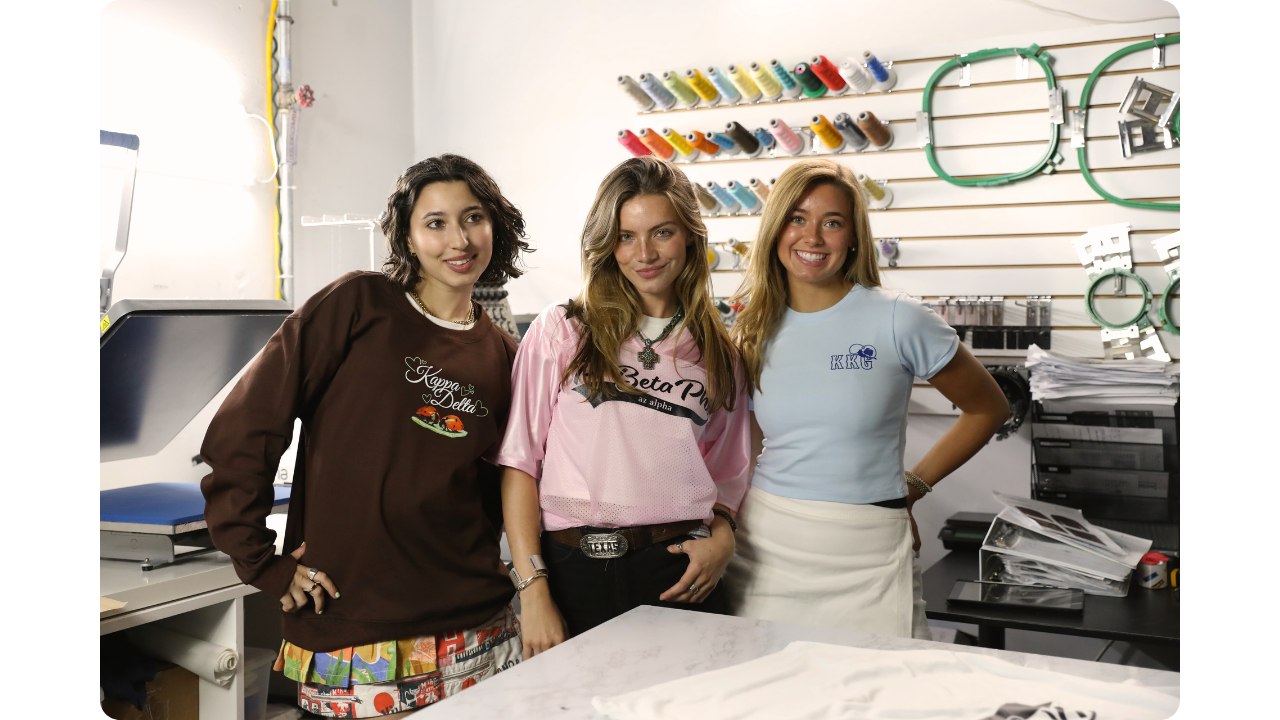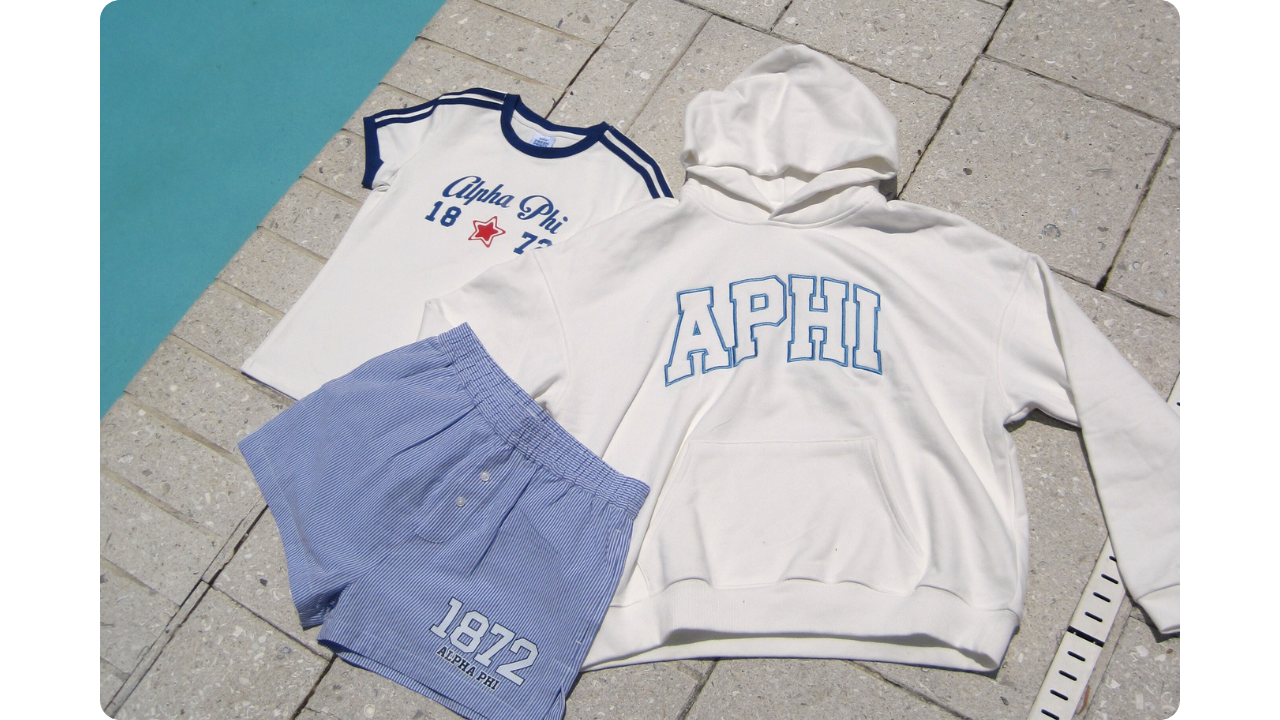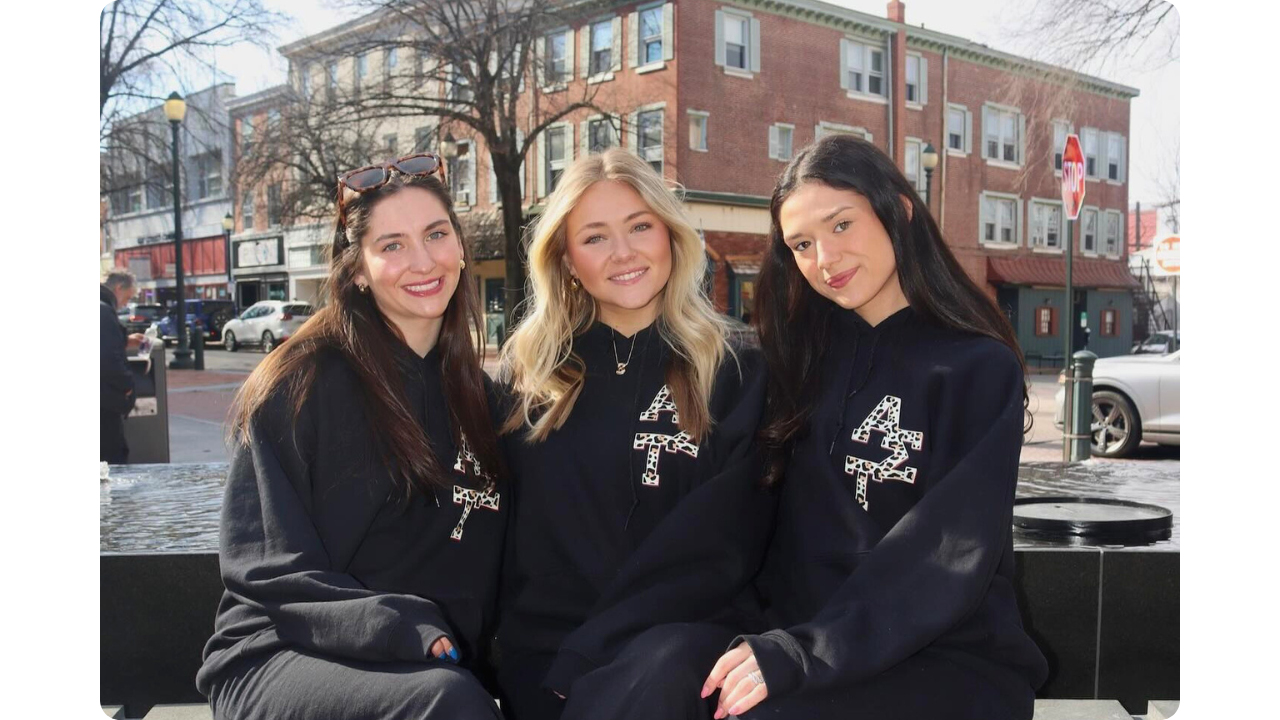What Are DTF Transfers? How It Works and When to Use It for Custom Apparel
TL;DR
- DTF transfers create vibrant, durable, full-color designs with faster turnaround.
- Fresh Prints is one of the best merch companies for DTF transfers.
- DTF printing is best for multicolor, gradient, fine-detail art; great on cotton, blends, hats, bags.
- Avoid ultra-stretchy or heat-sensitive fabrics; follow sizing guide and care to maximize longevity.
- Browse Fresh Prints’ Design Gallery for DTF-ready designs and use the Design Tool to mock up your order.
If you’ve ever designed custom shirts for your chapter, club, or campus event, you’ve probably heard about DTF transfers. And if you’re a new apparel chair trying to understand all the ropes, don’t worry, this guide will help. DTF printing is one of the fastest-growing print methods in college merch—and for good reason.
At Fresh Prints, we’ve produced over 40,000 DTF transfer merch orders, making it our 4th most-used print type for collegiate, sorority, and fraternity merch.
But what exactly is DTF? How does it work? And when should you choose it over other options like screen printing or embroidery? Let’s break it all down.
How do DTF transfers work?
DTF stands for Direct-to-Film. The design is printed onto a special film, dusted with adhesive powder, and then heat-pressed onto the garment. DTF Transfers have unlimited colors and print using CMYK. That’s it!
No messy screens, no color limits, and no long setup times. Here’s how it goes step-by-step:
- Your design is printed onto a clear PET film using DTF-specific inks (including a white underbase so the colors pop on dark fabrics).
- While the ink is still wet, a powdered adhesive is applied to the back.
- The print is cured and ready to press.
- Using a heat press, the design is transferred to a shirt, hoodie, tote bag—whatever you’re customizing.
- The film is peeled and given one final press for durability, then it’s done.
Think of it as a sticker-meets-screen-print hybrid, but way more durable and flexible.
(For more on the science behind it, check out DTFSheet’s technical guide.)

What are the benefits of using DTF prints?
DTF is one of the most versatile print methods out there. Whether you’re ordering shirts for your chapter’s next retreat or custom hoodies for your exec board, here’s why it’s worth considering:
It works on (almost) everything.
DTF sticks to cotton, polyester, blends, hoodies, and totes like a pro. You don’t have to pre-treat or switch print methods every time your group changes garment types. Just avoid ultra-stretchy materials or fabrics that can’t handle the heat press evenly (like certain nylons or waterproof jackets).
Your designs actually pop.
Using white ink helps each print keep its colors bright and crisp, especially on dark or bold fabrics. If your logo has fine details, gradients, or small lettering, DTF keeps it sharp—something traditional screen printing can struggle with.
Faster turnaround, fewer headaches.
Unlike screen printing, DTF doesn’t need multiple screens or long prep times. Because designs are printed on film ahead of time, pressing them onto garments is quick. So if your event got approved last minute or your supplier for a different print type fell through, DTF can save you.
Built to last.
When the initial print is applied correctly and the shirt or item is properly taken care of, DTF prints hold up through dozens of washes without cracking or fading. It’s the same kind of durability you’d expect from high-quality screen prints, just with more color range.
Budget-friendly for small student orgs.
You won’t pay for extra setup fees or screen charges when using DTF printing. That means smaller groups can still get premium-looking merch without blowing the budget.
When should I use DTF for custom apparel?
Use DTF transfer when you need full-color designs, want flexibility across fabrics, or need smaller quantities without sacrificing quality. Based on all the DTF orders we’ve done at Fresh Prints, here are specific scenarios where we think using DTF is best:
- If your design is pocket-sized but has a gradient effect
- If you have a multi-colored design but are ordering less than 10 items or don’t reach the minimum order quantity with screen print
- If your design has more than 8 colors and you’re using a t-shirt with less than 80% cotton (such as 50/50s, 100% polyester, <50% cotton blends)
- If you want a multi-colored design on any backpack or cooler and don’t want embroidery
- If you want a mult-colored design on a 6-panel hat
- If you’re doing a repeat order

What’s the print size chart for DTF transfers?
If you’re using DTF transfer, the size of your design depends on its print location. Here’s a quick guide you can reference before you order:
| Location | Max Size |
| Front and back | 15"w x 19"h |
| T-Shirt Pocket | Max Pocket Area but it must be 0.25" away from the seam |
| On sleeves | Across the width of the sleeve x 19"h |
| Pant legs | Across the width of the pant legs x 19"h |
| Shorts | Across the width and height of the shorts; it must be 0.25" away from the seam |
| Kids garments | Along the width and height of the garment; it must be 0.25" away from the seam and not exceeding 15"w x 19"h. |
| 5-panel and Bucket hats | 4"w x 3"h |
If you use our Design Tool, we have additional guide boxes that show you how big your design can be (+ how close it can be to any seams) based on the product you’ve selected. Check out our Help Center for more info on how to use the Design Tool.
Pro tip: When you work with Fresh Prints, you can also request a physical sample of your product or do a test print to make sure everything’s exactly how you want it before it goes into full production. It’s the easiest way to avoid misprints and errors!
Where can I get free DTF designs for sorority or fraternity apparel?
The Fresh Prints Design Gallery has a specific page for the trendiest DTF-compatible designs for any sorority, fraternity, or club.
Just head over to the gallery and filter the designs based on event type, style, what’s most favorited, or what’s new. You can also use the search bar to describe exactly what you’re looking for.
We have another blog that shares the best platforms to use when you need more merch design inspo. And remember: no matter where your designs come from, always make sure the merch company you’re working with is officially licensed.
Frequently Asked Questions
How long do DTF transfers last?
With proper washing (cold water, inside-out, no high heat drying or ironing), DTF prints can last as long as screen prints.
Is DTF good for t-shirts?
Absolutely. DTF is one of the best options for creating custom shirts because it’s color-rich, durable, and cost-effective for smaller orders.
What are the disadvantages of DTF printing?
Like any print method, DTF has a few trade-offs:
- The print can feel slightly thicker than DTG or screen print.
- For massive bulk orders, screen printing can still be cheaper.
- Application requires precision (heat, pressure, peel timing).
- Check our Help Center for more info on DTF limitations
Still, for small-to-mid-sized org merch orders, the pros far outweigh the cons.
What type of shirt is best for DTF transfers?
DTF works best on cotton or cotton-blend shirts, but it can also be used on poly- and tri-blends. Here are the specific apparel products we recommend for DTF transfers.

Why Choose Fresh Prints for Your Next Custom Apparel Order?
If you're making merch for your chapter, club, or campus event, DTF is honestly one of the easiest ways to get it done right. It works on pretty much anything, looks super clean, and won’t take forever to print. Whether you’re doing PR tees, philanthropy shirts, or something just for your officers, DTF makes it simple to pull off a solid drop without the usual stress.
And since Fresh Prints has already handled 40,000+ DTF merch orders, you can trust we know what we’re doing. Check out the DTF-ready designs in our Design Gallery, then use the Design Tool to make it yours. Happy customizing!
